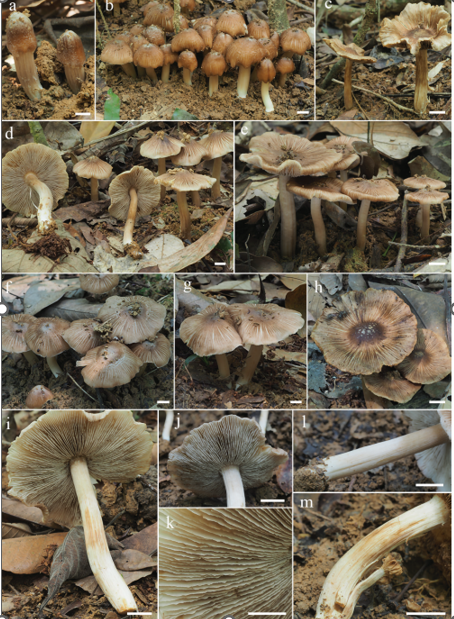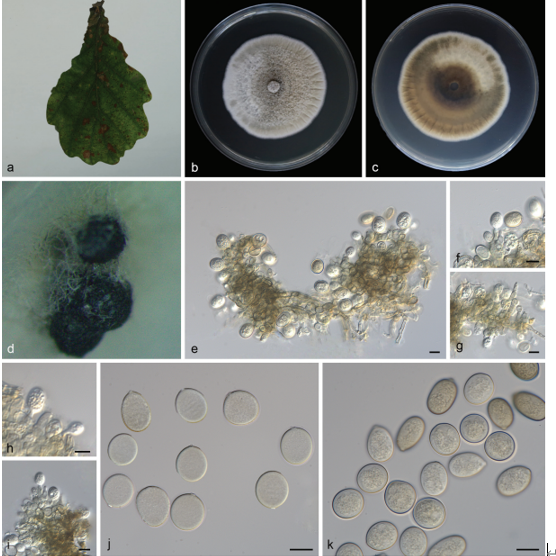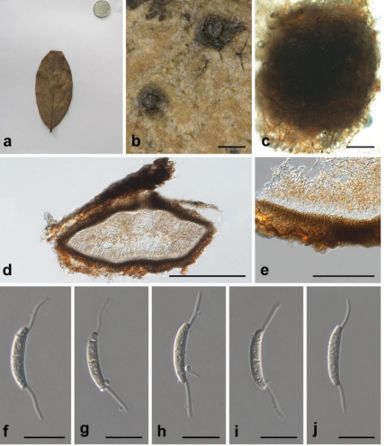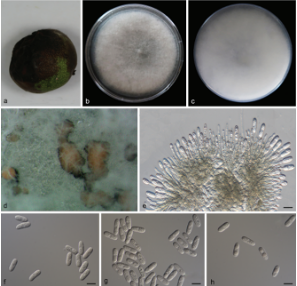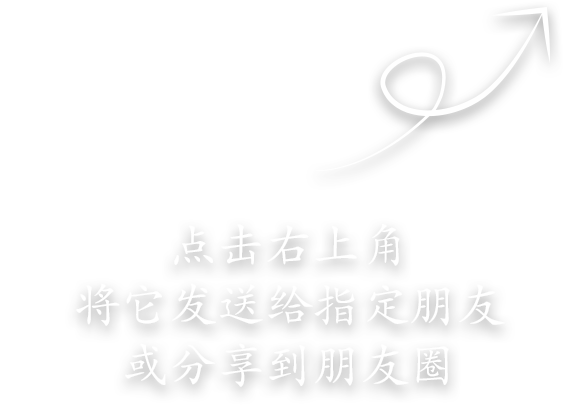Russula straminella G.J. Li & C.Y. Deng, sp. nov.2021
Fungal Names: FN 570758
Holotype: China, Guizhou Province, Guiyang City, Yunyan District, Guizhou Botany Garden, 26°37'N, 106°43'E, alt. 1107 m, on the ground in coniferous forest, 8 July 2017, C.Y. Deng 2017–209 (HGAS-MF 009922, Holotype). GenBank acces sion: MN649195 (ITS).
Morphological description
Sexual morph: Basidiomata small to medium sized. Pileus 33–57 mm in diam., initially flat to hemispherical, then plano-convex to applanate, finally often concave at centre, gelatinised, yellowish to brownish-yellow tinged, intermixed with brown ish fringe, Argus Brown (III13m), Warm Sepia (XXIX13′′m), to Verona Brown (XXIX13′′k) at centre, rarely with a paler tinge of Mikado Brown (XXIX13′′i), Rood’s Brown (XXVIII11′′k) to Cacao Brown (XXVIII9′′i); margin acute to subacute, enrolled when young, often undulate, sometimes cracked when mature, tuberculate-striate 8–15 mm from the edge inwards, peeling 1/5–1/4 towards the centre, first Aniline Yellow (IV19i), Sayal Brown (XXIX15′′) to Cinnamon Buff (XXIX15′′d), finally Mi kado Brown (XXIX13′′i), Snuff Brown (XXIX15′′k) to Clay Colour (XXIX17′′). Lamel lae adnate, fragile, occasionally forked near the stipe and pileus margin, interveined, f irst White (LIII), then of Cream Colour (XVI19′f) when mature, often having an ochraceous tinge of Olive Ochre (XXX21′′), Isabella Colour (XXX19′′i) to Honey Yel low (XXX19′′) when bruised, taste mild to slightly acrid; edge even, narrowing to wards the pileus edge, 8–16 pieces per cm in the edge; lamellulae rare. Stipe central, 3.5–6.5 × 1–1.5 cm, cylindrical, slightly tapering towards the base, annulus absent, f irst smooth, slightly longitudinally rugulose when mature, White (LIII) when young, turning a pale brownish-yellow tinge of Kaiser Brown (XIV9′k), Aniline Yellow (IV19i) to Buckthorn Brown (XV17′i) after bruising, initially stuffed, fistulous to hollow when mature. Context White first, slowly turning a pale ochraceous tinged of Yellow Ochre (XV17′) to Ochraceous-Buff (XV15′b) when injured, 2–4 mm thick at the centre of pileus, compact; taste mild, rarely slightly acrid, with no distinct odour. Spore print cream coloured (Romagnesi IIc–IId).
Basidiospores [150/6/3] (5.4–) 5.8–7.1 (–7.6) × (4.7–) 5.1–6.5 μm, Q = (1.00–) 1.03–1.28 (–1.31) (Q = 1.15 ± 0.07), 6.4 × 5.6 μm in average, globose, subglobose to broadly ellipsoid, rarely ellipsoid, ornamentation amyloid, composed of verrucous to conical warts 0.7–1 μm in height, often linked by fine lines as short ridges, partly reticulate, rarely isolated; suprahilar area inamyloid, but distinct. Basidia 33–40 ×9–11 μm, hyaline, often yellowish in KOH, subclavate to clavate, sometimes cylin drical, mostly with four sterigmata 4–7 μm long. Hymenial cystidia rare, less than 500/mm2, 56–70 × 8–10 μm, clavate to subclavate, rarely subfusiform, projecting 20–40 μm beyond hymenium, apex rounded, contents sparse, granular, evenly dis tributed, pale greyish in SV. Pileipellis two-layered, clearly distinguished from the subjacent sphaerocytes. Suprapellis 70–130 μm thick, acid-resistant encrustations absent, a trichoepithelium at pileus centre, partly an ixo-trichoepithelium, com posed of erect to suberect hyphae, terminal cells cylindrical, 20–40 × 3–5 μm, obtuse at apex, partly ventricose, subapical cells sometimes inflated, rarely branched, 15–25 × 8–12 μm, an ixotrichoderm at pileus margin, composed of erect to ascending, rarely repent hyphae, terminal cells 30–55 × 3–5 μm, cylindrical, often thick-walled, tapered to mucronate at apex. Pileocystidia abundant, often fasciculate at pileus cen tre, narrowly lanceolate to bayonet-shaped, 30–60 × 5–8 μm, one-celled, contents granular, blackish-grey in SV. Pileocystidia sparse at the pileus margin, cylindrical, 4–8 μm in width, slightly tapered at apex, contents grey in SV. Subpellis composed ofloosely interwoven, mostly repent, septate hyphae often inflated, 3–8 μm in width. Clamp connections absent in all tissues.
Asexual morph: Undetermined
Culture characteristics:
Habitat: Single to scattered on yellow brown soil in coniferous forest dominated by Pinus armandii and P. massoniana at 1100–1400 m altitude.
Distribution: China (Guizhou).
GenBank Accession:
MN649194
MN649195
MN649189
Notes: This new species can be distinguished from members of R. sect. Ingra tae described from China and the Himalayan region as follows: Russula gelatinosa, R. guangdongensis Z.S. Bi & T.H. Li, R. punctipes, R. senecis, R. subpunctipes and R. tsokae have basidiospore ornamentation composed of high wings (often above 2 μm), ranging over long distances or even encircling (Bi and Li 1986; Song et al. 2018, 2020). The Asian species of R. sect. Ingratae, R. ahmadii, R. natarajanii and R. pseudopectinatoides have basidiospore ornamentation lower than 0.7 μm (Das et al. 2006; Li et al. 2015b; Jabeen et al. 2017). For species that have similar basidiospore ornamentation, R. ab botensis has reddish-brown to purplish-red tinges on pileus surface, pruinose to scurfy stipe at base, larger basdiospores, 8–10 × 7.3–8.5 μm and hymenial cystidia with mu cronate apices (Das and Sharma 2005); R. arunii has pileus turning light orange to greyish-orange when old, context having a fishy odour and narrow pileocystidia 3–4 μm in width (Crous et al. 2017); R. indocatillus has hymenial cystidia with mucronate, capitate, moniliform, rostrate or appendiculate apex with cylindrical or slightly inflat ed subapical cells (Ghosh et al. 2020); R. obscuricolor has a pale yellowish-white tinge in pileus margin, pungent and bitterish context, narrow pileocystidia 3–5 μm in width (Das et al. 2017); R. pseudocatillus has greyish-brown pileus centre, towards the margin very pale yellow, larger basidiospores, 7–9 μm in diam. and narrower pileocystidia (3–6 μm in width) unchanging in SV (Yuan et al. 2019); R. rufobasalis has reddish stipe base, mucronate or appendiculate apex of hymenial cystidia and thick-walled terminal cells (Song et al. 2018).
Reference: Li, G. J., Li, S. M., Buyck, B., Zhao, S. Y., **e, X. J., Shi, L. Y., ... & Li, M. (2021). Three new Russula species in sect. Ingratae (Russulales, Basidiomycota) from southern China. MycoKeys, 84, 103.
Figure 2. Basidiomata B Russula straminella. Bars: 10 mm.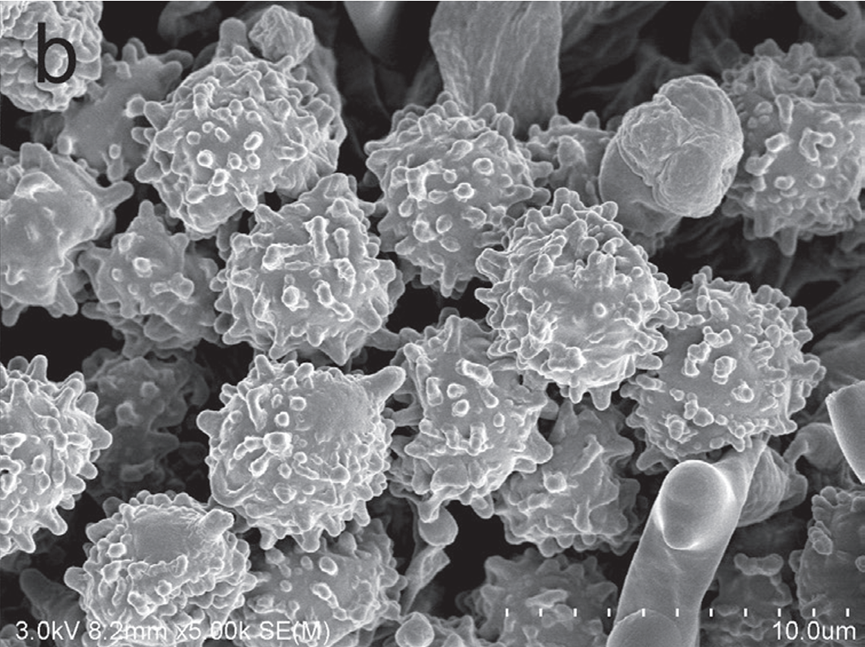
Figure 3. SEM photo of basidiospores B Russula straminella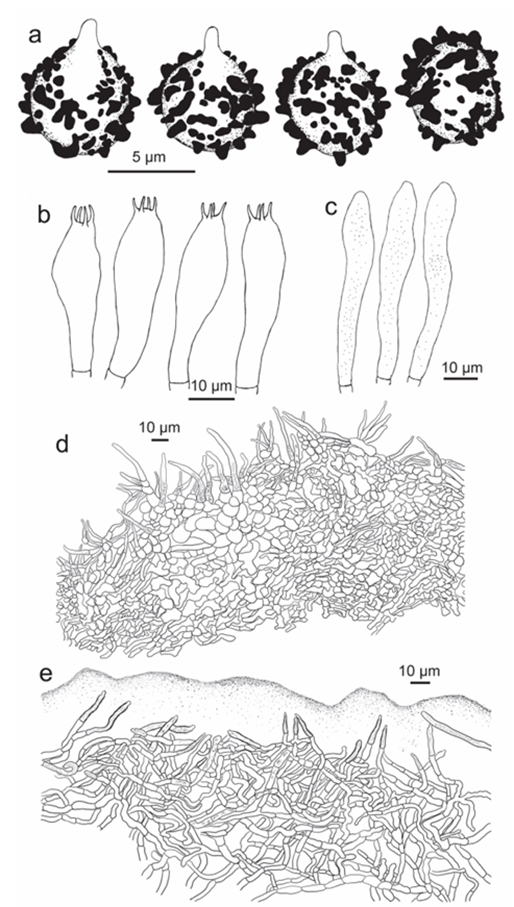
Figure 6. Russula straminella, holotype A basidiospores B basidia C hymenial cystidia D suprapellis and partial subpellis in pileus centre E suprapellis in pileus margin. 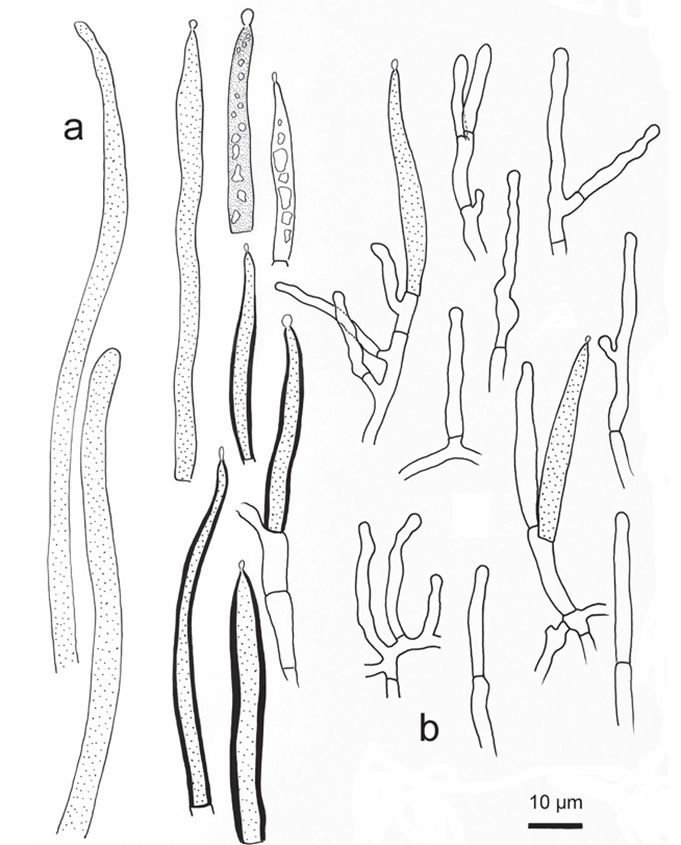
Figure 7. Russula straminella, holotype A hyphal ends in pileipellis margin B hyphal ends in pileus centre.


